Identifying and Characterizing Candidate Genes Contributing to a Grain Yield QTL in Wheat
Abstract
:1. Introduction
2. Results
2.1. Physical Location of the QTL in the Wheat Genome
2.2. Gene Functional Annotation
2.3. Expressional Behaviour of the Genes (HC)
2.4. Protein–protein Interaction and Biochemical Pathway Analysis
2.5. Function Analysis of the HC Genes
2.6. Selecting the Candidate Genes for Lab-Based Investigation
2.7. Polymorphism of Candidate Genes between Parental Cultivars
2.8. Association of Polymorphic Genes with the Yield
3. Materials and Methods
3.1. Database Selection
3.2. Basic Local Alignment Search Tool (BLAST)
3.3. Gene Expression Data Collection and Analysis
3.4. Functional Annotation Analysis
3.5. SNP Data Collection
3.6. Kyoto Encyclopedia of Genes and Genomes Pathway
3.7. Protein–protein Interaction Prediction and Literature Support
3.8. Gene Amplification and Sequencing Analysis
3.9. RNA Extraction, cDNA Synthesis, and Quantitative PCR
4. Discussions
4.1. Tetratricopeptide Repeat (TPR)-like Gene
4.2. Ferredoxin-like Gene
4.3. Glutamine Synthetase Gene
4.4. Sulphite Reductase Gene
5. Conclusions
Supplementary Materials
Author Contributions
Funding
Data Availability Statement
Conflicts of Interest
References
- Abdurakhmonov, I.Y. Bioinformatics—Updated features and applications. In Bioinformatics: Basics, Development, and Future; IntechOpen: London, UK, 2016. [Google Scholar] [CrossRef]
- Adamski, N.M.; Borrill, P.; Brinton, J.; Harrington, S.A.; Marchal, C.; Bentley, A.R.; Bovill, W.D.; Cattivelli, L.; Cockram, J.; Moreira, B.C.; et al. A roadmap for gene functional characterisation in crops with large genomes: Lessons from polyploid wheat. In eLife; eLife Sciences Publications Ltd.: Cambridge, UK, 2020; Volume 9. [Google Scholar] [CrossRef]
- An, D.; Su, J.; Liu, Q.; Zhu, Y.; Tong, Y.; Li, J.; Jing, R.; Li, B.; Li, Z. Mapping QTLs for nitrogen uptake in relation to the early growth of wheat (Triticum aestivum L.). Plant Soil 2006, 284, 73–84. [Google Scholar] [CrossRef]
- Anderson, W.B.; Stadtman, E.R. Glutamine synthetase deadenylation: A phosphorolytic reaction yielding ADP as nucleotide product. Biochem. Biophys. Res. Commun. 1970, 41, 704–709. [Google Scholar] [CrossRef]
- Appels, R.; Eversole, K.; Feuillet, C.; Keller, B.; Rogers, J.; Stein, N.; Pozniak, C.J.; Stein, N.; Choulet, F.; Distelfeld, A.; et al. Shifting the limits in wheat research and breeding using a fully annotated reference genome. Science 2018, 361, eaar7191. [Google Scholar] [CrossRef]
- Bhoite, R.; Onyemaobi, I.; Si, P.; Siddique, K.H.M.; Yan, G. Identification and validation of QTL and their associated genes for pre-emergent metribuzin tolerance in hexaploid wheat (Triticum aestivum L.). BMC Genet. 2018, 19, 102. [Google Scholar] [CrossRef]
- Chang, H.; Huang, H.E.; Cheng, C.F.; Ho, M.H.; Ger, M.J. Constitutive expression of a plant ferredoxin-like protein (pflp) enhances capacity of photosynthetic carbon assimilation in rice (Oryza sativa). Transgenic Res. 2017, 26, 279–289. [Google Scholar] [CrossRef]
- Chen, J.; Aronow, B.J.; Jegga, A.G. Disease candidate gene identification and prioritization using protein interaction networks. BMC Bioinform. 2009, 10, 73. [Google Scholar] [CrossRef]
- Chomczynski, P.; Mackey, K. Modification of the TRI Reagent procedure for isolation of RNA from polysaccharide- and proteoglycan-rich sources. Biotechniques 1995, 19, 942–945. [Google Scholar]
- Colín-Castro, C.A.; Franco-Cendejas, R.; Rocha-González, H.I.; Cruz-Arenas, E.; Leyva-García, N.; Sánchez-Sánchez, R.; Leyva-Gomez, G.; Gómez, R.; Muñoz, B.; Cortés, H.; et al. Association of TLR4 gene polymorphisms with sepsis after a burn injury: Findings of the functional role of rs2737190 SNP. Genes Immun. 2021, 22, 24–34. [Google Scholar] [CrossRef]
- Crane, B.R.; Siegel, L.M.; Getzoff, E.D. Sulfite reductase structure at 1.6 A: Evolution and catalysis for reduction of inorganic anions. Science 1995, 270, 59–67. [Google Scholar] [CrossRef]
- Franken, P.; Donges, K.; Grunwald, U.; Kost, G.; Rexer, K.H.; Tamasloukht, M.; Waschke, A.; Zeuske, D. Gene expression analysis of arbuscule development and functioning. Phytochemistry 2007, 68, 68–74. [Google Scholar] [CrossRef]
- Haigh, N.S.W.; Suchecki, R.; Kalashyan, E.; Garcia, M.; Baumann, U. DAWN: A resource for yielding insights into the diversity among wheat genomes. BMC Genom. 2018, 19, 941. [Google Scholar] [CrossRef]
- Heeswijk, W.C.; Rabenberg, M.; Westerhoff, H.V.; Kahn, D. The genes of the glutamine synthetase adenylylation cascade are not regulated by nitrogen in Escherichia coli. Mol. Microbiol. 1993, 9, 443–457. [Google Scholar] [CrossRef] [PubMed]
- Herath, V.; Verchot, J. Insight into the bZIP Gene Family in Solanum tuberosum: Genome and Transcriptome Analysis to Understand the Roles of Gene Diversification in Spatiotemporal Gene Expression and Function. Int. J. Mol. Sci. 2020, 22, 253. [Google Scholar] [CrossRef]
- Howe, K.L.; Moreira, B.C.; Silva, N.D.; Maslen, G.; Akanni, W.; Allen, J.; Jarreta, J.A.; Barba, M.; Bolser, D.M.; Cambell, L.; et al. Ensembl Genomes 2020-enabling non-vertebrate genomic research. Nucleic Acids Res. 2019, 48, D689–D695. [Google Scholar] [CrossRef] [PubMed]
- Kinsella, R.J.; Kähäri, A.; Haider, S.; Zamora, J.; Proctor, G.; Spudich, G.; King, J.A.; Staines, D.; Derwent, P.; Kerhornou, A.; et al. Ensembl BioMarts: A hub for data retrieval across taxonomic space. Database 2011, 2011, bar030. [Google Scholar] [CrossRef]
- Ming, M.X.; Lin, L.; Peng, Z.; Ping, X.S.; Fei, G. Effect of water control on activities ofnitrogen assimilation enzymes and grain quality in winter wheat. Chin. J. Plan Ecol. 2005, 29, 48–53. [Google Scholar] [CrossRef]
- Pflieger, S.; Lefebvre, V.; Causse, M. The candidate gene approach in plant genetics: A review. Mol. Breed. 2001, 7, 275–291. [Google Scholar] [CrossRef]
- Platt, A.R.; Woodhall, R.W.; George, A.L. Improved DNA sequencing quality and efficiency using an optimized fast cycle sequencing protocol. Biotechniques 2007, 43, 58–62. [Google Scholar] [CrossRef]
- QIAGEN CLC Genomics Workbench. Available online: https://digitalinsights.qiagen.com/products-overview/discovery-insights-portfolio/analysis-and-visualization/qiagen-clc-genomics-workbench/ (accessed on 8 August 2020).
- Qiu, Y.Q. KEGG Pathway Database. Encycl. Syst. Biol. 2013, 1068–1069. [Google Scholar] [CrossRef]
- Ramírez-González, R.H.; Borrill, P.; Lang, D.; Harrington, S.A.; Brinton, J.; Venturini, L.; Davey, M.; Jacobs, J.; Ex F van Pasha, A.; Khedikar, Y.; et al. The transcriptional landscape of polyploid wheat. Science 2018, 361, 3083–3109. [Google Scholar] [CrossRef]
- Saito, K.; Saito, Y.H.; Funatsuki, W.M.; Sato, Y.; Kato, A. Physical mapping and putative candidate gene identification of a quantitative trait locus Ctb1 for cold tolerance at the booting stage of rice. Theor. Appl. Genet. 2004, 109, 515–522. [Google Scholar] [CrossRef]
- Salvi, S.; Bellotti, M.; Conti, S.; Frascaroli, E.; Giuliani, S.; Landi, P.; Maccaferri, M.; Natoli, V.; Sanguineti, M.C.; Sponza, G.; et al. The art and science of cloning QTLs in plants. In The Wake of the Double Helix: From the Green Revolution to the Gene Revolution; Avenue Media: Bologna, Italy, 2005; pp. 327–345. [Google Scholar]
- Schapire, A.L.; Valpuesta, V.; Botella, M.A. TPR Proteins in Plant Hormone Signaling. Plant Signal. Behav. 2006, 1, 229–230. [Google Scholar] [CrossRef] [PubMed]
- Schön, C.C.; Utz, H.F.; Groh, S.; Truberg, B.; Openshaw, S.; Melchinger, A.E. Quantitative trait locus mapping based on resampling in a vast maize testcross experiment and its relevance to quantitative genetics for complex traits. Genetics 2004, 167, 485–498. [Google Scholar] [CrossRef] [PubMed]
- Seo, J.H.; Kang, B.K.; Dhungana, S.K.; Oh, J.H.; Choi, M.S.; Park, J.H.; Shin, S.O.; Kim, H.S.; Baek, I.Y.; Sung, J.S.; et al. QTL mapping and candidate gene analysis for pod shattering tolerance in soybean (Glycine max). Plants 2020, 9, 1163. [Google Scholar] [CrossRef]
- Sharma, M.; Pandey, G.K. Expansion and function of repeat domain proteins during stress and development in plants. Front. Plant Sci. 2016, 6, 1218. [Google Scholar] [CrossRef]
- Shastry, B.S. SNPs: Impact on gene function and phenotype. Methods Mol. Biol. 2009, 578, 3–22. [Google Scholar] [CrossRef] [PubMed]
- Singh, A.K.; Chaurasia, S.; Kumar, S.; Singh, R.; Kumari, J.; Yadav, M.C.; Singh, N.; Gaba, S.; Jacob, S.R. Identification, analysis and development of salt responsive candidate gene based SSR markers in wheat. BMC Plant Biol. 2018, 18, 249. [Google Scholar] [CrossRef] [PubMed]
- Šramková, Z.; Gregová, E.; Šturdík, E. Genetic improvement of wheat-A review. Nova Biotechnol. 2009, 9, 27–51. [Google Scholar] [CrossRef]
- Szklarczyk, D.; Gable, A.L.; Nastou, K.C.; Lyon, D.; Kirsch, R.; Pyysalo, S.; Doncheva, N.T.; Legeay, M.; Fang, T.; Bork, P.; et al. The STRING database in 2021: Customizable protein-protein networks, and functional characterization of user-uploaded gene/measurement sets. Nucleic Acids Res. 2020, 49, D605–D612. [Google Scholar] [CrossRef]
- Terasawa, Y.; Ito, M.; Tabiki, T.; Nagasawa, K.; Hatta, K.; Nishio, Z. Mapping of a major QTL associated with protein content on chromosome 2B in hard red winter wheat (Triticum aestivum L.). Breed. Sci. 2016, 66, 471–480. [Google Scholar] [CrossRef]
- Zhao, Y. Genetic Dissection of Wheat Nitrogen Use Efficiency Related Traits; Murdoch University: Perth, Australia, 2019. [Google Scholar]
- Kawakami, K.; Watanabe, G. Identification and Functional Analysis of Single Nucleotide Polymorphism in the Tandem Repeat Sequence of Thymidylate Synthase Gene. Cancer Res. 2003, 63, 6004–6007. [Google Scholar] [PubMed]
- Kumar, A.; Kumar, A.; Tyagi, P.; Singh, K.P. Identification and functional characterization an ortholog of OsENOD93-1 gene in wheat using in silico approach. Int. J. Curr. Microbiol. Appl. Sci. 2018, 7, 3240–3250. [Google Scholar] [CrossRef]
- Kuzay, S.; Xu, Y.; Zhang, J.; Katz, A.; Pearce, S.; Su, Z.; Fraser, M.; Anderson, J.A.; Guedira, G.B.; DeWitt, N.; et al. Identification of a candidate gene for a QTL for spikelet number per spike on wheat chromosome arm 7AL by high-resolution genetic mapping. Theor. Appl. Genet. 2019, 132, 2689–2705. [Google Scholar] [CrossRef] [PubMed]
- Lin, Y.H.; Huang, L.F.; Hase, T.; Huang, H.E.; Feng, T.Y. Expression of plant ferredoxin-like protein (PFLP) enhances tolerance to heat stress in Arabidopsis thaliana. New Biotechnol. 2015, 32, 235–242. [Google Scholar] [CrossRef] [PubMed]
- Liu, H.; Mullan, D.; Zhang, C.; Zhao, S.; Li, X.; Zhang, A.; Lu, Z.; Wang, Y.; Yan, G. Major genomic regions responsible for wheat yield and its components as revealed by meta-QTL and genotype–phenotype association analyses. Planta 2020, 252, 65. [Google Scholar] [CrossRef]
- Ma, L.; Li, T.; Hao, C.; Wang, Y.; Chen, X.; Zhang, X. TaGS5-3A, a grain size gene selected during wheat improvement for larger kernel and yield. Plant Biotechnol. J. 2016, 14, 1269–1280. [Google Scholar] [CrossRef]
- Miles, C.M.; Wayne, M. Quantitative trait locus (QTL) analysis. Nat. Educ. 2018, 1, 208. [Google Scholar]
- Moolna, A.; Bowsher, C.G. The physiological importance of photosynthetic ferredoxin NADP+ oxidoreductase (FNR) isoforms in wheat. J. Exp. Bot. 2010, 61, 2669–2681. [Google Scholar] [CrossRef]
- Livak, K.J.; Schmittgen, T.D. Analysis of relative gene expression data using real-time quantitative PCR and the 2−ΔΔCT method. Methods 2001, 25, 402–408. [Google Scholar] [CrossRef]
- Wang, C.; Chen, S.; Yu, S. Functional markers developed from multiple loci in GS3 for fine marker-assisted selection of grain length in rice. TAG. Theoretical and Applied Genetics. Theor. Appl. Genet. 2011, 122, 905–913. [Google Scholar] [CrossRef]
- Wang, M.; Jia, Y.; Xu, Z.; Xia, Z. Impairment of sulfite reductase decreases oxidative stress tolerance in Arabidopsis thaliana. Front. Plant Sci. 2016, 7, 1843. [Google Scholar] [CrossRef] [PubMed]
- Wei, Y.; Xiong, S.; Zhang, Z.; Meng, X.; Wang, L.; Zhang, X.; Yu, M.; Yu, H.; Wang, X.; Ma, X. Localization, gene expression, and functions of glutamine synthetase isozymes in wheat grain (Triticum aestivum L.). Front. Plant Sci. 2021, 12, 580405. [Google Scholar] [CrossRef]
- Xu, L.; Liu, H.; Kilian, A.; Bhoite, R.; Liu, G.; Si, P.; Wang, J.; Zhou, W.; Yan, G. QTL mapping using a high-density genetic map to identify candidate genes associated with metribuzin rolerance in hexaploid wheat (Triticum aestivum L.). Front. Plant Sci. 2020, 11, 1440. [Google Scholar] [CrossRef]
- Yarmolinsky, D.; Brychkova, G.; Fluhr, R.; Sagi, M. Sulfite Reductase Protects Plants against Sulfite Toxicity. Plant Physiol. 2013, 161, 725–743. [Google Scholar] [CrossRef]
- Yarmolinsky, D.; Brychkova, G.; Kurmanbayeva, A.; Bekturova, A.; Ventura, Y.; Goldberg, I.K.; Eppel, A.; Fluhr, R.; Sagi, M. Impairment in sulfite reductase leads to early leaf senescence in tomato plants. Plant Physiol. 2014, 165, 1505–1520. [Google Scholar] [CrossRef] [PubMed]
- Yuan, F.P.; Zeng, Q.D.; Wu, J.H.; Wang, Q.L.; Yang, Z.J.; Liang, B.P.; Kang, Z.S.; Chen, X.H.; Han, D.J. QTL mapping and validation of adult plant resistance to stripe rust in Chinese wheat landrace Humai 15. Front. Plant Sci. 2018, 9, 968. [Google Scholar] [CrossRef] [PubMed]
- Zhu, M.; Zhao, S. Candidate gene identification approach: Progress and challenges. Int. J. Biol. Sci. 2007, 3, 420–427. [Google Scholar] [CrossRef] [PubMed]
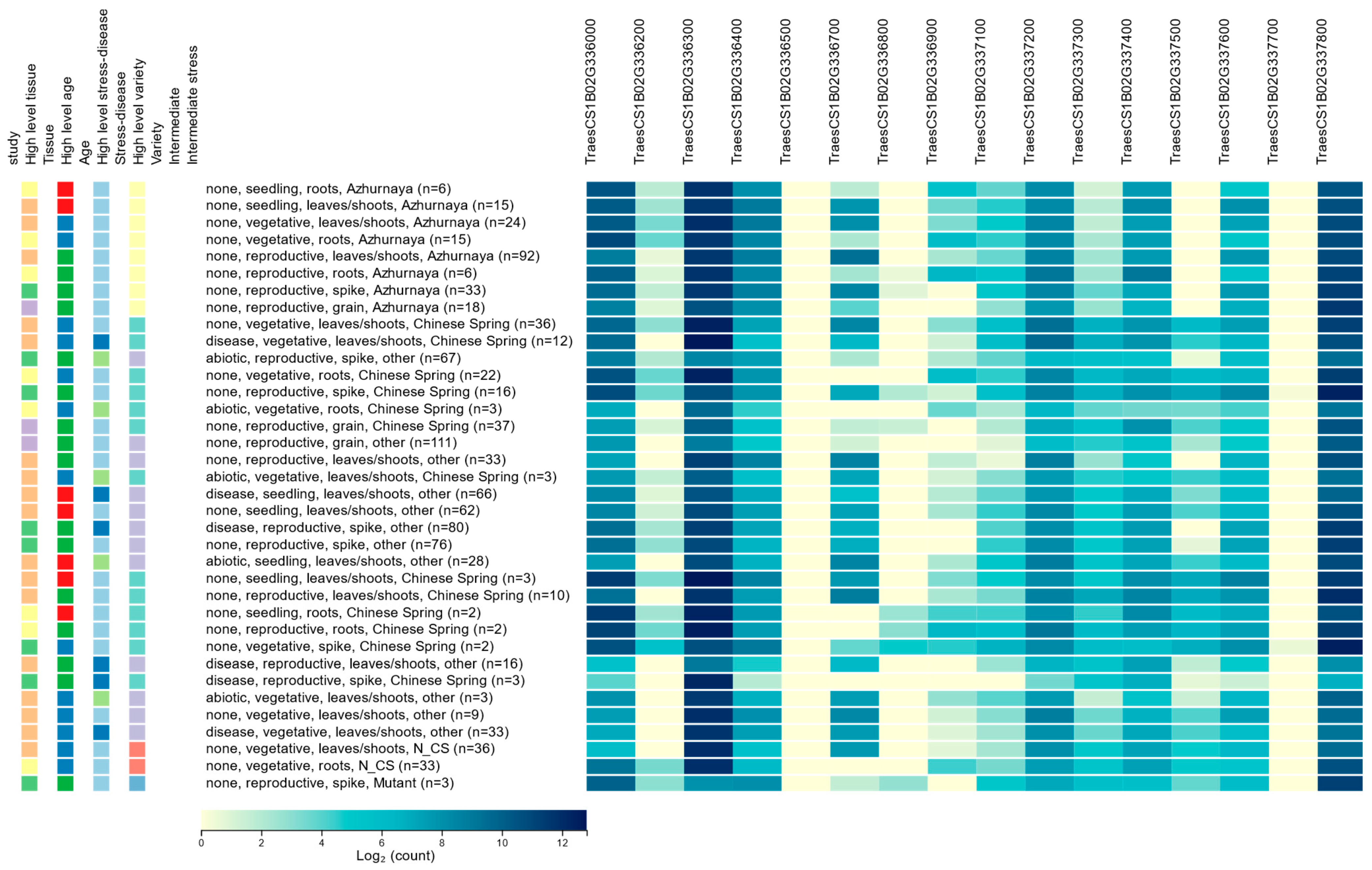
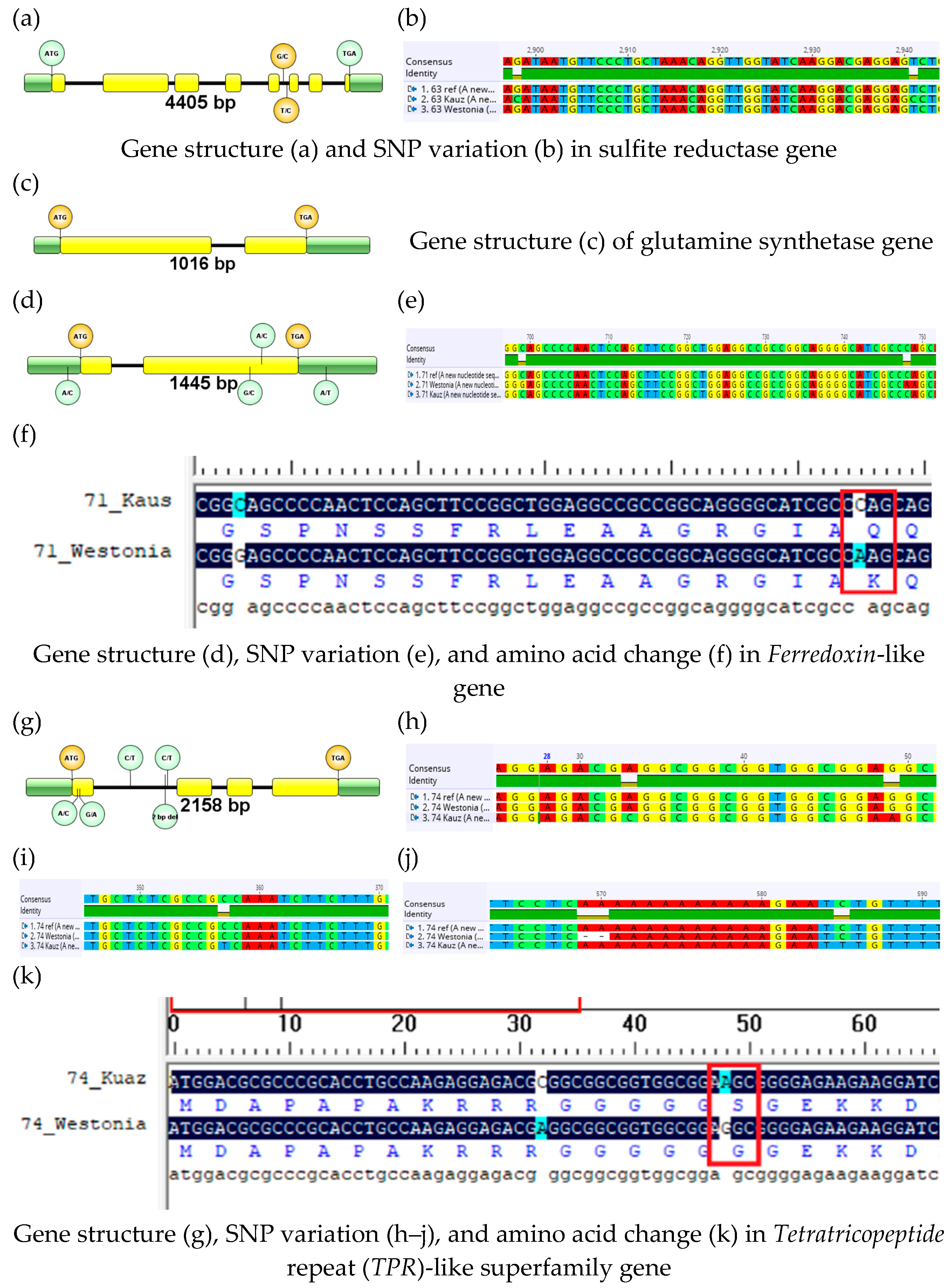
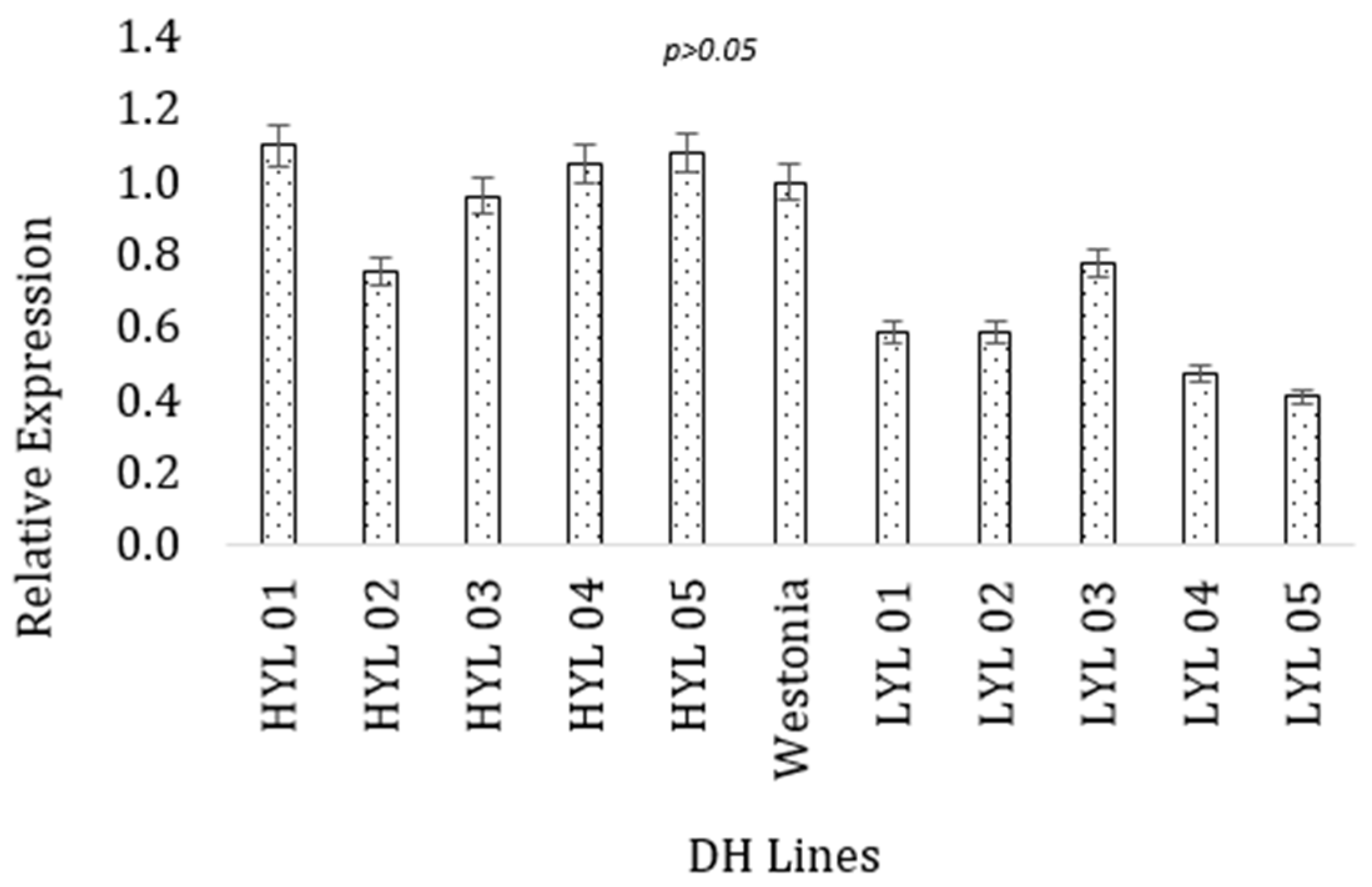
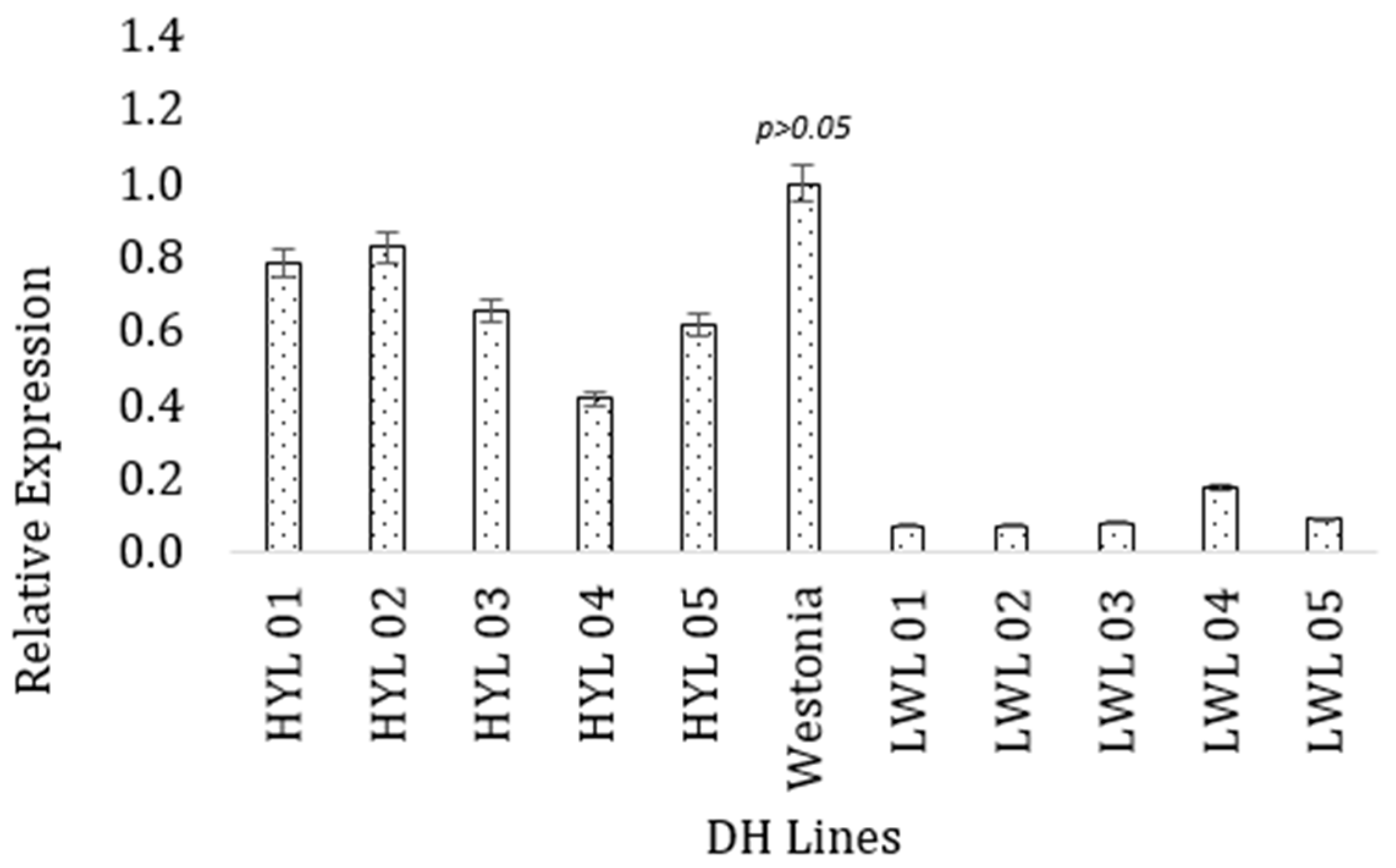
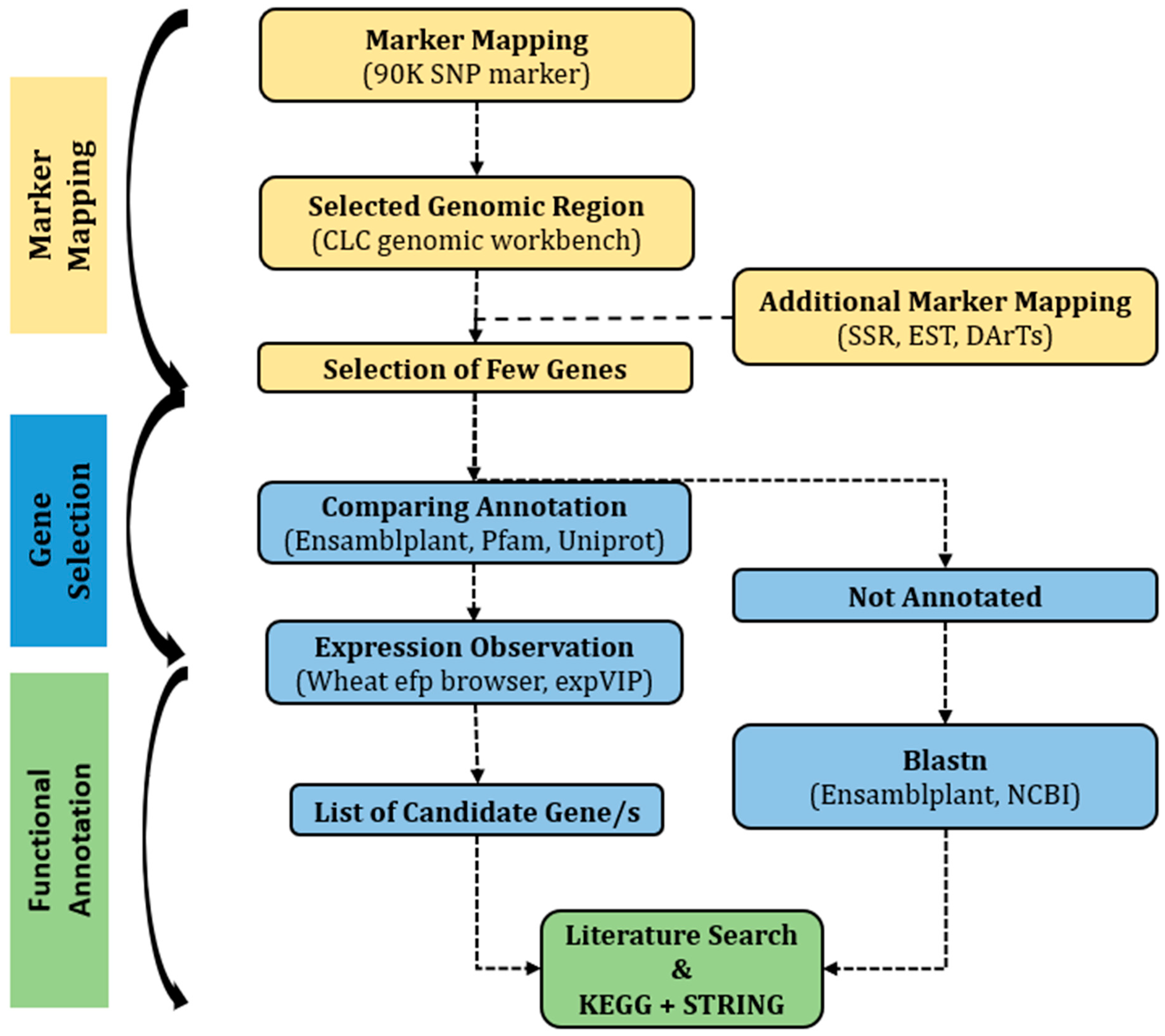
| Gene Ids | Annotation Description | Expression Level | Target Trait-Related | Scoring | Further Study |
|---|---|---|---|---|---|
| TraesCS1B02G336000 | Secretory carrier-associated membrane protein | Low | NTT | 2 | N/R |
| TraesCS1B02G336200 | WEB family protein (DUF827) | Low | NTT | 2 | N/R |
| TraesCS1B02G336300 | Sulfite reductase [NADPH] hemoprotein beta-component | Medium/High | TT | 1 | Recommended |
| TraesCS1B02G336400 | ATP-dependent DNA helicase Hel308 | Low | NTT | 3 | N/R |
| TraesCS1B02G336500 | RING/U-box superfamily protein | No | NTT | 3 | N/R |
| TraesCS1B02G336700 | NBS-LRR disease-resistance protein | Low | DR/NTT | 3 | N/R |
| TraesCS1B02G336800 | Bifunctional glutamine synthetase adenylyltransferase/adenylyl-removing enzyme | Low | TT | 1 | Recommended |
| TraesCS1B02G336900 | Clavata3/ESR (CLE) gene family member | Low | NTT | 3 | N/R |
| TraesCS1B02G337100 | Ferredoxin-like | Low | TT | 1 | Recommended |
| TraesCS1B02G337200 | Rac-like GTP-binding protein | Low | DR/NTT | 3 | N/R |
| TraesCS1B02G337300 | LRR receptor-like serine/threonine-protein kinase FLS2 | Low | DR/NTT | 3 | N/R |
| TraesCS1B02G337400 | Tetratricopetide repeat (TPR)-like superfamily protein | Medium/High | TT | 1 | Recommended |
| TraesCS1B02G337500 | Actin cross-linking protein, putative | No | NTT | 3 | N/R |
| TraesCS1B02G337600 | ARM repeat superfamily protein | Low | NTT | 3 | N/R |
| TraesCS1B02G337700 | Actin cross-linking protein, putative | No | NTT | 3 | N/R |
| TraesCS1B02G337800 | Transcription elongation factor Spt5-like protein | Medium | NTT | 2 | N/R |
| Serial No. | Feature ID |
|---|---|
| Candidate gene 1 | Sulfite reductase [NADPH] hemoprotein beta-component (TraesCS1B02G336300) |
| Candidate gene 2 | Bifunctional glutamine synthetase adenylyltransferase/adenylyl-removing enzyme (TraesCS1B02G336800) |
| Candidate gene 3 | Ferredoxin-like (TraesCS1B02G337100) |
| Candidate gene 4 | Tetratricopetide repeat (TPR)-like superfamily protein (TraesCS1B02G337400) |
| Gene Id | Genomic Position | Gene Size (bp) | Protein Size (aa) | Number of Exons | Number of Introns | SNP Variation in Exon | Total SNPs | Amino Acid Change | Protein Structure Change |
|---|---|---|---|---|---|---|---|---|---|
| TraesCS1B02G336300 | 563,031,942–563,027,538 | 4405 | 636 | 8 | 7 | - | 2 | - | - |
| TraesCS1B02G336800 | 563,787,308–563,788,323 | 1016 | 213 | 2 | 1 | - | - | - | - |
| TraesCS1B02G337100 | 564,161,126–564,162,570 | 1445 | 255 | 2 | 1 | 2 | 2 | Yes | No |
| TraesCS1B02G337400 | 564,907,284–564,909,441 | 2158 | 301 | 4 | 3 | 2 | 4 | Yes | No |
Disclaimer/Publisher’s Note: The statements, opinions and data contained in all publications are solely those of the individual author(s) and contributor(s) and not of MDPI and/or the editor(s). MDPI and/or the editor(s) disclaim responsibility for any injury to people or property resulting from any ideas, methods, instructions or products referred to in the content. |
© 2023 by the authors. Licensee MDPI, Basel, Switzerland. This article is an open access article distributed under the terms and conditions of the Creative Commons Attribution (CC BY) license (https://creativecommons.org/licenses/by/4.0/).
Share and Cite
Saieed, M.A.U.; Zhao, Y.; Islam, S.; Ma, W. Identifying and Characterizing Candidate Genes Contributing to a Grain Yield QTL in Wheat. Plants 2024, 13, 26. https://doi.org/10.3390/plants13010026
Saieed MAU, Zhao Y, Islam S, Ma W. Identifying and Characterizing Candidate Genes Contributing to a Grain Yield QTL in Wheat. Plants. 2024; 13(1):26. https://doi.org/10.3390/plants13010026
Chicago/Turabian StyleSaieed, Md Atik Us, Yun Zhao, Shahidul Islam, and Wujun Ma. 2024. "Identifying and Characterizing Candidate Genes Contributing to a Grain Yield QTL in Wheat" Plants 13, no. 1: 26. https://doi.org/10.3390/plants13010026





